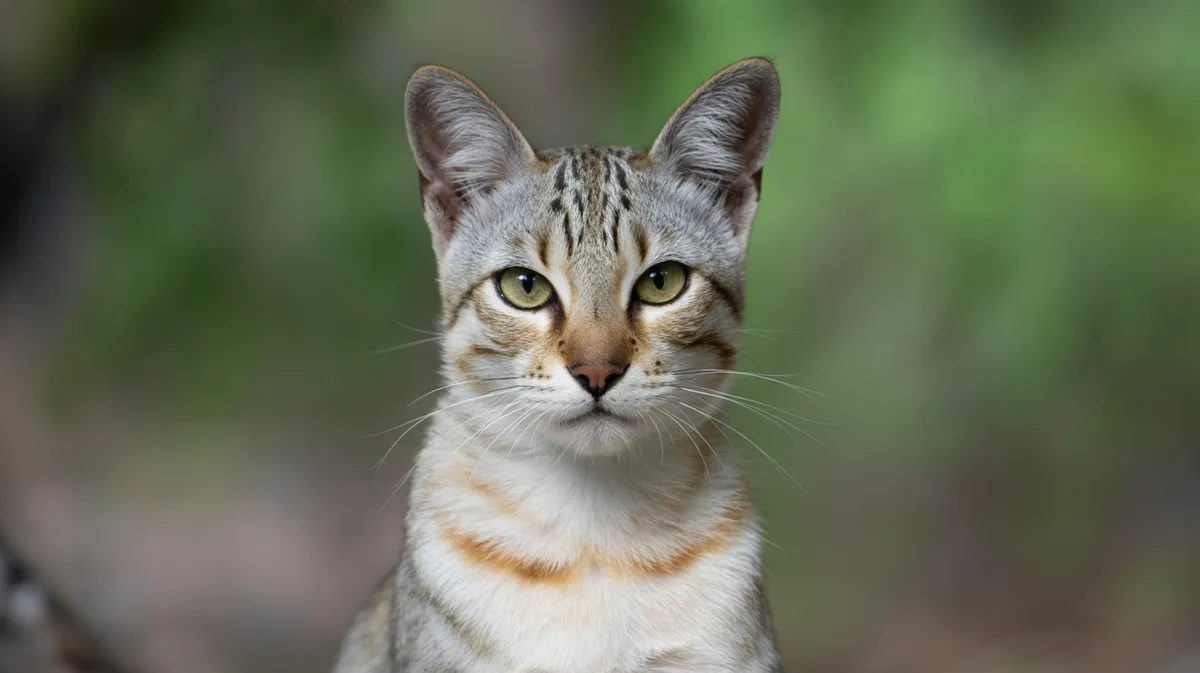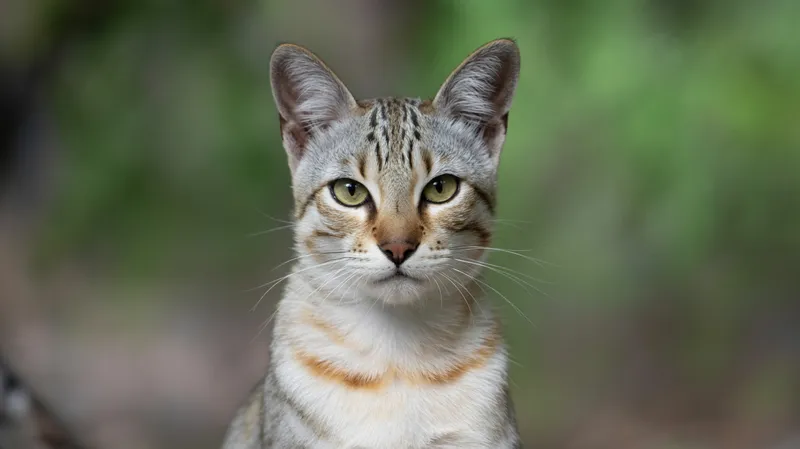
Thai Cat
Felis catus

Meet the Thai Cat
The Thai cat, also known as the Traditional Siamese, is a graceful and elegant breed known for its striking blue almond-shaped eyes and sleek, muscular build. Originating in Thailand, this breed is the natural, classic form of the Siamese cat, displaying a moderate, less extreme body type compared to modern Siamese cats. Thai cats are highly social, vocal, and intelligent, forming strong bonds with their human companions. Their short, fine coat typically features a pointed coloration, with darker fur on the ears, face, paws, and tail.
Classification
Mammal
Habitat
Domestic; originally from Southeast Asian villages and towns
Diet
Carnivore
Lifespan
12-18 years
Conservation
Least Concern
Weight
3-6 kg
📖Fascinating Facts
Vocal Nature
Thai cats are renowned for their expressive voices and will often communicate extensively with their owners.
Striking Eyes
They have deep blue, almond-shaped eyes that are a signature trait of the breed.
Ancient Lineage
Thai cats are depicted in manuscripts from the Ayutthaya period in Thailand, dating back over 200 years.
📋Detailed Description
The Thai cat, Felis catus, is a medium-sized, muscular feline with a lithe yet robust build, reflecting its origins as a naturally occurring landrace in Thailand. Adults typically weigh between 3.5 and 6 kg, with males generally larger than females. The breed is characterized by a gently rounded head, broad at the cheekbones, and a distinctively 'apple-shaped' skull, in contrast to the elongated wedge of the modern Siamese. Their eyes are large, almond-shaped, and a deep, vivid blue, a hallmark of the breed. The coat is short, glossy, and close-lying, with a fine texture and minimal undercoat, displaying the classic pointed pattern: a pale body with darker extremities (seal, blue, chocolate, lilac, and other point colors). Thai cats are renowned for their agility and athleticism, capable of impressive leaps and swift movements. They are highly vocal, using a wide range of meows, trills, and chirps to communicate with humans and other cats. Socially, Thai cats are affectionate and thrive in interactive environments, often forming strong bonds with family members and seeking constant companionship. Their intelligence is notable, as they are quick learners, adept at puzzle toys, and can even be trained to perform tricks or walk on a leash.
💡 Did you know?
Unlike the modern Siamese, the Thai cat preserves the traditional look and characteristics of cats depicted in ancient Thai manuscripts from centuries ago.
🔬Research & Sources
Wikipedia Summary
The Thai or Wichien Maat is a newly renamed but old cat breed, related to but different from the Western, modern-style Siamese cat. This natural breed is descended from the cats of Thailand, and, among various groups of breeders in different times and places, has also been called the Old-Style Siamese, Traditional Siamese, Classic Siamese; Wichien Maat ; and the Applehead, a nickname that originated in the 1950s. According to The International Cat Association: "The Thai is the breed dedicated to preserving the native pointed cat of Thailand in as close to its original form as possible."
Last Modified: 1/1/2025
🎭Behavior & Social Structure
Thai cats exhibit a high degree of sociability and curiosity, often following their owners from room to room and engaging in interactive play. In multi-cat households, they establish clear social hierarchies but are generally tolerant and cooperative, displaying affiliative behaviors such as allogrooming and communal sleeping. Their vocalizations serve both to attract attention and to express needs or emotions, and some individuals develop unique 'conversations' with their humans. Thai cats retain strong predatory instincts, engaging in stalking, pouncing, and mock hunting behaviors, especially when provided with appropriate toys. They are crepuscular, showing peak activity at dawn and dusk, and may adapt their routines to match those of their human companions. Feeding behavior is opportunistic; while obligate carnivores, they show interest in novel foods and can be prone to obesity if overfed. Environmental enrichment is essential for their mental health, as boredom can lead to destructive behaviors or excessive vocalization.
👶Reproduction & Life Cycle
Thai cats reach sexual maturity between 5 and 12 months of age. Females are seasonally polyestrous, with peak breeding activity in spring and summer, though indoor cats may cycle year-round. Estrus lasts 4-7 days, during which females vocalize intensely and display lordosis. Mating is often preceded by courtship behaviors such as mutual grooming and nuzzling. Gestation averages 63-65 days, resulting in litters of 3-6 kittens. Queens exhibit strong maternal instincts, providing attentive care, nursing, and grooming their offspring. Kittens are born with pale coats; point coloration develops over the first weeks as temperature-sensitive pigment genes are activated. Weaning occurs at 8-10 weeks, and socialization with humans and other animals during this period is critical for behavioral development.
🛡️Adaptations & Survival
The Thai cat's pointed coloration is a result of a temperature-sensitive mutation in the tyrosinase gene, leading to darker pigmentation on cooler body parts—a classic adaptation for camouflage in the dappled light of Southeast Asian environments. Their short, fine coat is well-suited to the warm, humid climate of Thailand, reducing the risk of overheating. Large, wide-set ears enhance auditory acuity, aiding in the detection of prey and environmental cues. Their highly flexible bodies and strong hind limbs facilitate agile climbing and leaping, advantageous for arboreal hunting and escape from predators. Behaviorally, their sociability and vocal communication are thought to be adaptations to life in close proximity to humans and other cats in village settings.
🎨Cultural Significance
The Thai cat, known locally as Wichien Maat, holds a revered place in Thai culture and folklore. Historically, these cats were kept by royalty and Buddhist monks, believed to bring good luck and spiritual protection. They are featured in the ancient Tamra Maew ('Cat Book Poems'), a manuscript dating to the Ayutthaya Kingdom (14th-18th centuries), which describes their auspicious qualities. In temple art and literature, the Wichien Maat is depicted as a guardian and companion. The breed's export to the West in the late 19th century led to the development of the modern Siamese, but the traditional form remains a symbol of national heritage in Thailand.
🔬Recent Research & Discoveries
Recent genetic studies have confirmed the distinctiveness of the Thai cat from both modern Siamese and other Southeast Asian breeds, with unique mitochondrial DNA haplotypes and allele frequencies. Ongoing research focuses on the inheritance of point coloration, health screening for breed-specific conditions (such as amyloidosis and progressive retinal atrophy), and the impact of selective breeding on temperament. Behavioral studies highlight the breed's advanced social cognition and problem-solving abilities. Conservation-oriented research in Thailand is documenting the diversity of native cat populations to support breed preservation efforts internationally.
🎥Wildlife Videos

Pallas's cat - แมวพัลลัส แมวที่หาตัวยากและลึกลับมาก |สารคดีสัตว์ WILDLIFE
สารคดีใหม่#สารคดีสัตว์#เรื่องน่ารู้#ชีวิตสัตว์มหัศจรรย์ ▻สารคดีสัตว์โลก และเรื่องราวที่น่าสนใจอยู่ที่นี่แล้ว WILDLIFE ...
WILDLIFE Thailand

Binturong: The Bearcat that is Neither Bear nor Cat
The Binturong looks like the mix between a bear, a cat, and a monkey, but they're more than the sum of their weird-looking parts.
Animalogic

A blue Fairy, one tough pussy cat and dive bombed by a killer
Thailand nature: Wild in Bangkok Nature and the beauty of Bangkok Suburbs with jokes and naughty humour. 4k footage Biology ...
Wild in Bangkok

Pet Series | Cat-2 | Epic Wildlife| #25
Hello Friends ! Welcome to Epic Wildlife ! Hope you all are fit and fine. Today is the second video of Cat Series of the Pet Series.
Amazing Wildlife

Why Do Cats Hunt? | Cats Uncovered | BBC Earth
Why do pet cats continue to hunt despite being fed at home, the team set out to investigate. Taken from Cats Uncovered.
BBC Earth
🌍Habitat Information
The Thai Cat typically inhabits Domestic; originally from Southeast Asian villages and towns environments. Thai Cats have adapted to their environments with specialized features and behaviors.
Primary Habitat:
Domestic; originally from Southeast Asian villages and towns
More detailed habitat information will be available soon.
🛡️Conservation Status
The Thai Cat is currently classified as Least Concern. Conservation efforts are crucial for preserving this species for future generations.
Common Threats:
- 🏠Habitat loss and fragmentation
- 🌡️Climate change impacts
- 🎯Hunting and poaching
- 🏭Human-wildlife conflict
⚠️Threats & Conservation Challenges
As a domestic breed, Thai cats are not threatened in the wild, but preservation of the traditional phenotype faces challenges from crossbreeding with modern Siamese and other breeds. In Thailand, feral and semi-feral populations are subject to risks such as disease, traffic accidents, and habitat loss due to urbanization. Globally, the breed's genetic diversity is a concern, as small founding populations in the West may lead to inbreeding depression. Responsible breeding programs aim to maintain health and genetic integrity. No significant population declines have been reported, and the breed is classified as 'Least Concern.' However, ongoing vigilance is needed to prevent dilution of the breed's unique characteristics.
🔬Scientific Classification
Scientific Name
Felis catus
Classification Hierarchy
🔍 About Taxonomic Classification
Taxonomic classification is a hierarchical system used by scientists to classify and organize living organisms based on shared characteristics and evolutionary relationships.
The system moves from broad categories (Kingdom) to increasingly specific ones, with each animal's scientific name typically consisting of its Genus and species.
📝Community Notes
Share your observations and insights about the Thai Cat with our community of wildlife enthusiasts.
Join Our Community
Sign in to share your observations and connect with fellow wildlife enthusiasts.
Sign In to ContributeNo community notes yet
Be the first to share your observations about the Thai Cat!
Explore Thai Cat
Select a tab above to learn more about this amazing animal.
📸Photo Gallery
No photos available for this animal yet.
🌟Discover More Wildlife
Continue your journey of discovery with more fascinating animals from our database
